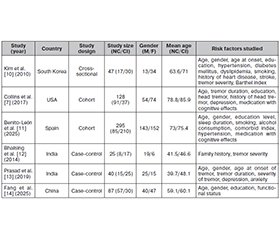Международный неврологический журнал Том 21, №4, 2025
Вернуться к номеру
Поширеність і фактори ризику когнітивних порушень при есенціальному треморі: систематичний огляд та метааналіз
Авторы: Aristo Rinaldi Pangestu (1), Rizal Tumewah (1), Ansye Grace Nancy Momole (1), Windy Mariane Virenia Wariki (1), Seilly Yunita Jehosua (1), Junita Maja Pertiwi (2)
(1) - Faculty of Medicine, Sam Ratulangi University, Manado, Indonesia
(2) - Memory Clinic, Neurorestoration Clinic, Faculty of Medicine, Sam Ratulangi University, Manado, Indonesia
Рубрики: Неврология
Разделы: Клинические исследования
Версия для печати
Актуальність. Когнітивні порушення майже втричі частіше спостерігаються в пацієнтів з есенціальним тремором (ЕТ), ніж у загальній популяції. Проведено багато досліджень щодо поширеності й факторів ризику когнітивних порушень при ЕТ, однак їх результати були суперечливими, що зумовлює необхідність метааналізу для отримання статистично обґрунтованих висновків. Матеріали та методи. Відповідно до настанов PRISMA виконано систематичний пошук досліджень щодо факторів ризику когнітивних порушень при ЕТ. У метааналіз були включені обсерваційні дослідження, у яких чітко визначено ЕТ із когнітивними порушеннями й наведено відповідні дані. Дані проаналізовано для отримання загального розміру ефекту та 95% довірчого інтервалу (ДІ). Упередженість публікацій оцінювали за допомогою тесту Еггера. Результати. У ході систематичного пошуку було виявлено 2891 публікацію. До остаточного аналізу включено 6 досліджень. Когнітивні порушення виявлено в 56,1 % пацієнтів з ЕТ. Когнітивні порушення при есенціальному треморі позитивно корелювали з віком (g Хеджеса = 0,47, ДІ: 0,24–0,70; p = 0,00) і тривалістю тремору (g Хеджеса = 0,44, ДІ: 0,06–0,82, p = 0,02). Встановлено зворотний зв’язок між тривалістю навчання й когнітивними порушеннями при ЕТ (g Хеджеса = –0,36; ДІ: від –0,68 до –0,04; p = 0,03). Висновки. Когнітивні порушення вражають понад половину пацієнтів з есенціальним тремором. Вищий рівень освіти є захисним фактором щодо розвитку когнітивних порушень при ЕТ, тоді як похилий вік і довша тривалість тремору збільшують ризик їх виникнення.
Background. Cognitive impairment was nearly three times more likely to occur in patients with essential tremor (ET) than in the general population. There has been a lot of research on the prevalence and risk factors of cognitive impairment in ET, but the findings have been inconsistent, so a meta-analysis study is required to provide a statistical basis for them. Materials and methods. A systemic search for studies on risk factors of cognitive impairment in ET was performed based on the PRISMA guidelines. Observational studies that clearly defined ET with cognitive impairment and presented relevant data were included. The data were analyzed to generate a pooled effect size and 95% confidence interval (CI). Publication bias was assessed using the Egger’s test. Results. A systematic search was conducted and yielded 2891 articles. Six studies were included in the final analysis following screening. Cognitive impairment is present in 56.1 % of ET patients. The cognitive impairment in ET positively correlated with age (Hedges’ g = 0.47, CI: 0.24–0.70; p-value = 0.00) and tremor duration (Hedges’ g = 0.44, CI: 0.06–0.82, p-value = 0.02). An inverse association was found between education duration and cognitive impairment in ET (Hedges’ g = –0.36; CI: –0.68 to –0.04; p-value = 0.03). Conclusions. Cognitive impairment affects over half of ET patients. Higher education is a protective factor against cognitive impairment in ET, while advanced age and longer tremor duration increase the risk of cognitive impairment in ET.
есенціальний тремор; деменція; когнітивні порушення; фактор ризику; предиктор
essential tremor; dementia; cognitive impairment; risk factor; predictor

